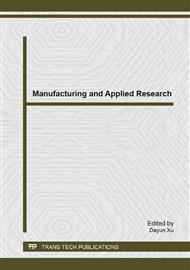[1]
Chen, M.S. &Lan, C.H. (2001a), Dynamic Production Plan of Probabilistic Market Demand and Fixed Selling Time with Unreliable Machines and Fixed Selling Time with Unreliable Machines and Obtainable Working Hour Capacity, Journal of the Operations Research Society of Japan, Vol. 44, pp.57-66.
DOI: 10.15807/jorsj.44.57
Google Scholar
[2]
Chen, M.S. &Lan, C.H. (2001b), Two-stage Production with Unreliable Machine and Finite Working Hour Capacity, International Journal of Information and Management Sciences, Vol. 12, , pp.11-24.
Google Scholar
[3]
Chen, M.S. & Chu, M.C. (2003), The Analysis of Optimal Control in Matching Problem Between Manufacturing and Marketing, European Journal of Operational Research, Vol. 150, pp.293-303.
DOI: 10.1016/s0377-2217(02)00495-2
Google Scholar
[4]
Chen, M.S. & Tsai F.C. (2008), The Optimal Production Plan under Limited Production Capacity at Any Point in Time. Journal of the Operations Research Society of Japan, Vol. 51, pp.81-94.
DOI: 10.15807/jorsj.51.81
Google Scholar
[5]
Chiang, A. (1992), Dynamic optimization, McGraw-Hill, Inc., Singapore.
Google Scholar
[6]
Feichtinger, G. & Harth, R. (1985), Optimal Pricing and Production in an Inventory Model, European Journal of Operational Research, Vol. 19, pp.45-56.
DOI: 10.1016/0377-2217(85)90307-8
Google Scholar
[7]
Flatto, L. (1979), Advanced Calculus, Second printing, Mei Ya Publications, Inc. Taipei, Taiwan.
Google Scholar
[8]
Friendman, A. (1983), Advanced Calculus, Fifth printing, Mei Ya Publications, Inc. Taipei, Taiwan.
Google Scholar
[9]
Gary M. K. & Hector H.G. (1990), A conceptual model for demand management in the assemble-to-order environment, Journal of Operations Management, Vol 9, pp.65-84.
Google Scholar
[10]
Grubbstrom, R.W. & Wang, Z. (2003), A stochastic Model of Multi-Level/Multi-stage Capacity Constrained Production-Inventory Systems, International Journal of Production Economics, Vol. 81, pp.483-494.
DOI: 10.1016/s0925-5273(02)00358-4
Google Scholar
[11]
Horiguchi, K., Raghavan, N., Uzsoy, R. & Venkateswaran, S. (2001), Finite Capacity Production Planning Algorithms for a Semiconductor wafer fabrication facility, International Journal of Production Research, Vol. 39, pp.825-842.
DOI: 10.1080/00207540010010253
Google Scholar
[12]
Kamien, M.I. & Schwartz, N.L. (1991), Dynamic Optimization: The Calculus of Variations and Optimal Control in Economics and Management, Second Edition, Elsevier, North Holland.
Google Scholar
[13]
Wu M.C. & Chen S.Y. (1997), A multiple criteria decision-making model for justifying the acceptance of rush orders, The Management of Operations, Vol8, Issue 8 December, p.753 – 761.
DOI: 10.1080/095372897234641
Google Scholar
[14]
Mohebbi E. & Choobineh F. (2005), The impact of component commonality in an assemble-to-order environment under supply and demand uncertainty. Omega, Vol 33, pp.472-482.
DOI: 10.1016/j.omega.2004.07.011
Google Scholar
[15]
Soroush, H. (1999), Sequencing and due-date determination in the Stochastic single machine problem with earliness and tardiness costs, European Journal of Operational Research, Vol. 113, pp.450-468.
DOI: 10.1016/s0377-2217(98)00003-4
Google Scholar
[16]
Sox, C. & Muckstadt, J. (1997), Optimization-based Planning for the Stochastic Lot-Scheduling Problem, IIE Transactions, Vol. 29, pp.349-357.
DOI: 10.1080/07408179708966340
Google Scholar
[17]
Jing, T.T., Hu Y., Feng Z., Hong, X.L., Hu X., Yan G. (2008), A full-scale solution to the rectilinear obstacle-avoiding Steiner problem, Integration, the VLSI Journal, Vol 41, Issue 3, May 2008, pp.413-425.
DOI: 10.1016/j.vlsi.2007.10.002
Google Scholar
[18]
Wu, M.C. & Chen, S.Y. (1996), Cost model for justifying the acceptance of rush orders, International Journal of Production Research, Vol. 34, p.1963-(1974).
DOI: 10.1080/00207549608905007
Google Scholar


